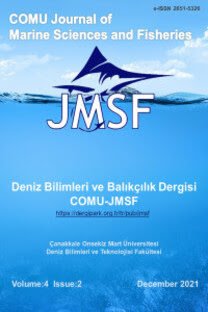Farklı Çözücülerin Gongolaria barbata'nın (Phaeophyceae) Antioksidan Özellikleri Üzerine Etkisi
Antioksidan özellikleri, Fenolik, Flavonoid, Gongolaria barbata, Kahverengi alg
The Effect of Different Solvents on Antioxidant Properties of Gongolaria barbata (Phaeophyceae)
Antioxidant properties, brown seaweed, flavonoids, Gongolaria barbata, phenolics.,
___
Ak, İ., & Türker, G. (2019). Antioxidant Activities of Eucheuma sp. (Rhodophyceae) and Laminaria sp. (Phaeophyceae). Turkish Journal of Agriculture - Food Science and Technology, 7, 154-159. doi: 10.24925/turjaf.v7isp1.154-159.2791Ak, İ., & Yücesan, M. (2012). Effect of light intensity on the pigment composition of Gracilaria verrucosa (Rhodophyta). Fresenius Environmental Bulletin 21 (2), 337-342.
Banwo, K., Olojede, A. O., Adesulu-Dahunsi, A. T., Verma, D. K., Thakur, M., Tripathy, S., Singh, S., Patel, A. R., Gupta, A. K., Aguilar, C. N., & Utama, G. L. (2021). Functional importance of bioactive compounds of foods with Potential Health Benefits: A review on recent trends. Food Bioscience, 43, 101320. doi: 10.1016/j.fbio.2021.101320
Beer, S., & Eshel, A. (1985). Determining phycoerythrin and phycocyanin concentrations in aqueous crude extracts of red algae. Marine and Freshwater Research, 36 (6), 785-792.
Bizzaro, G., Vatland, A.K., & Pampanin, D.M. (2022). The one-health approach in seaweed food production. Environment International, 158:106948. doi: 10.1016/j.envint.2021.106948
Brand-Williams, W., Cuvelier, M. E., & Berset, C. (1995). Use of a free radical method to evaluate antioxidant activity. LWT - Food Science and Technology, 28(1), 25-30. doi: 10.1016/S0023-6438(95)80008-5
Büchel, C. (2020). Light harvesting complexes in chlorophyll c-containing algae. Biochimica et Biophysica Acta (BBA) - Bioenergetics, 1861(4), 148027. doi: 10.1016/j.bbabio.2019.05.003
Cirik, Ş., Şen, E., & Ak, İ. (2010). Brown algae Cystoseira barbata (Stackhouse) C. Agardh culture and changes in it chemical composition. Journal of fisheriessciences.com, 4(4), 354-361. doi:10.3153/jfscom.2010038
Devi, A., Dwibedi, V., & Khan, Z. A. (2021). Natural antioxidants in new age-related diseases. Revista Brasileira de Farmacognosia, 31(4), 387-407. doi:10.1007/s43450-021-00175-0
Djeridane, A., Yousfi, M., Nadjemi, B., Boutassouna, D., Stocker, P., & Vidal, N. (2006). Antioxidant activity of some algerian medicinal plants extracts containing phenolic compounds. Food Chemistry, 97(4), 654-660. doi:https://doi.org/10.1016/j.foodchem.2005.04.028
Guiry, M. D., & Guiry, G. M. (2021). AlgaeBase. Access date: 07 October 2021, https://www.algaebase.org
Ismail, G. A. (2017). Biochemical composition of some Egyptian seaweeds with potent nutritive and antioxidant properties. Food Science and Technology, 37(2), 294-302. doi: 10.1590/1678-457x.20316
Jeffrey, S. W., & Humphrey, G. F. (1975). New spectrophotometric equations for determining chlorophylls a, b, c1 and c2 in higher plants, algae and natural phytoplankton. Biochemie und Physiologie der Pflanzen, 167(2), 191-194. doi: 10.1016/S0015-3796(17)30778-3
Jégou, C., Connan, S., Bihannic, I., Cérantola, S., Guérard, F., & Stiger-Pouvreau, V. (2021). Phlorotannin and pigment content of native canopy-forming sargassaceae species living in intertidal rockpools in Brittany (France): Any relationship with their vertical distribution and phenology? Marine Drugs, 19(9), 504-524. doi: 10.3390/md19090504
Koru, E., Yilmaz, M., Turker, G., & Ak, I. (2021). Antioxidant properties and element levels of two commercial Arthrospira strains. Phycologia. 60(sup1), 132-132. doi: 10.1080/00318884.2021.1922050
Ktari, L., Chebil Ajjabi, L., De Clerck, O., Gómez Pinchetti, J. L., & Rebours, C. (2021). Seaweeds as a promising resource for blue economy development in Tunisia: current state, opportunities, and challenges. Journal of Applied Phycology. doi:10.1007/s10811-021-02579-w
Mildenberger, J., Stangeland, J.K., Rebours, C. (2022). Antioxidative activities, phenolic compounds and marine food allergens in the macroalgae Saccharina latissima produced in integrated multi-trophic aquaculture systems. Aquaculture,546(15): 737386. doi: 10.1016/j.aquaculture.2021.737386
Osório, C., Machado, S., Peixoto, J., Bessada, S., Pimentel, F. B., C. Alves, R., & Oliveira, M. B. P. P. (2020). Pigments content (chlorophylls, fucoxanthin and phycobiliproteins) of different commercial dried algae. Separations, 7(2), 33. doi: 10.3390/separations7020033
Öztaşkent, C. & Ak, İ. (2021). Effect of LED light sources on the growth and chemical composition of brown seaweed Treptacantha barbata. Aquacult Int 29: 193–205 doi: 10.1007/s10499-020-00619-9
Quettier-Deleu, C., Gressier, B., Vasseur, J., Dine, T., Brunet, C., Luyckx, M., Cazin, M., Cazin, J.-C., Bailleul, F., & Trotin, F. (2000). Phenolic compounds and antioxidant activities of buckwheat (Fagopyrum esculentum Moench) hulls and flour. Journal of Ethnopharmacology, 72(1), 35-42. doi:https://doi.org/10.1016/S0378-8741(00)00196-
Ślusarczyk, J., Adamska, E., & Czerwik-Marcinkowska, J. (2021). Fungi and algae as sources of medicinal and other biologically active compounds: a review. Nutrients, 13(9), 3178. doi: 10.3390/nu13093178
Shubina, V.S., Kozina, V.I., & Shatalin, Y.V. (2021). Comparison of antioxidant properties of a conjugate of taxifolin with glyoxylic acid and selected flavonoids. antioxidants, 10:1262. doi: 10.3390/antiox10081262
Wang, H.-M. D., Li, X.-C., Lee, D.-J., & Chang, J.-S. (2017). Potential biomedical applications of marine algae. Bioresource Technology, 244, 1407-1415. doi: 10.1016/j.biortech.2017.05.198
Zhu, X., Healy, L.E.i Sevindik, O., Sun, D., Selli, S. Kelebek, H., Tiwari, B.K. (2022). Impacts of novel blanching treatments combined with commercial drying methods on the physicochemical properties of Irish brown seaweed Alaria esculenta. Food Chemistry, 369(1): 130949. doi: 10.1016/j.foodchem.2021.130949
- Yayın Aralığı: Yılda 2 Sayı
- Başlangıç: 2018
- Yayıncı: Çanakkale Onsekiz Mart Üniversitesi Deniz Bilimleri ve Teknolojisi Fakültesi
Hakkı DERELİ, M. Alp SALMAN, Okan ÖZAYDIN, Zafer TOSUNOĞLU
Çanakkale Boğazı’nda Pinna nobilis (Linnaeus, 1758) Popülasyonunda Ölüm Oranlarının Tespiti
Ata AKSU, Uğur ALTINAĞAÇ, Tekin DEMİRKIRAN
Farklı Çözücülerin Gongolaria barbata'nın (Phaeophyceae) Antioksidan Özellikleri Üzerine Etkisi
Melis YILMAZ, Gülen TÜRKER, İlknur AK
Dalyan-İztuzu (Doğu Akdeniz) Sahilinde Mikroplastik Kirliliğinin Araştırılması
Aytuğ ZİLİFLİ, Sezginer TUNCER
Auranga Halici (Valsad Bölgesi, Gujarat, Hindistan)'nde Fitoplankton Biyoçeşitliliği ve Bolluğu
Shefali S. PATEL, Susmita SAHOO
Priacanthus sagittarius Starnes, 1988’un Türkiye'nin Güneydoğu Akdeniz Kıyısına Menzil Genişlemesi
Mevlüt GÜRLEK, Deniz ERGÜDEN, Cemal TURAN
Farklı Çözücülerin Gongolaria barbata'nın (Phaeophyceae) Antioksidan Özellikleri Üzerine Etkisi
